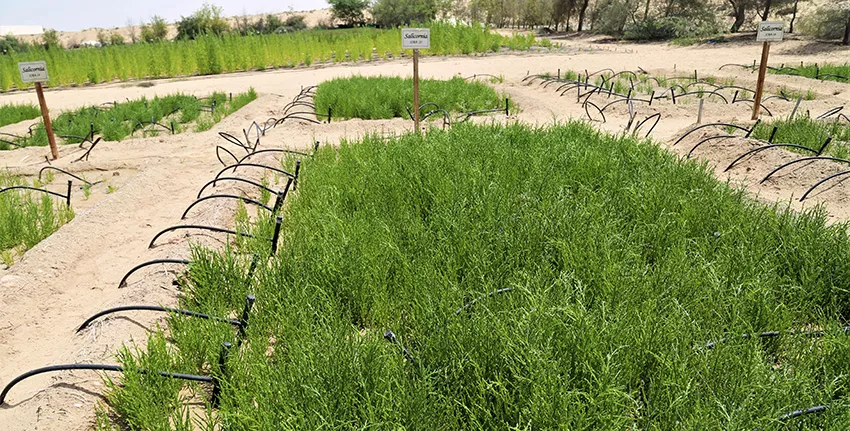ICBA achieves progress in breaking Salicornia yield ceiling
A team of scientists at the International Center for Biosaline Agriculture (ICBA) has made a major breakthrough in increasing yield potential of Salicornia, a multi-purpose halophyte.
Working closely with local partners in the UAE, the scientists have recently recorded a bumper seed yield of 3 tonnes per hectare (t/ha) using seawater passing through an aquaculture system. This is the first time Salicornia has produced such high yield under UAE conditions.
Salicornia is a salt-loving plant that can be used for food, forage and biofuel production.
Since 2011, ICBA, along with local partners, has carried out extensive studies on the potential of growing Salicornia under arid conditions. During several multi-year field trials at the center’s experimental station in Dubai, scientists evaluated more than 50 different Salicornia genotypes under highly saline conditions and selected the top high-yielding ones.
Dr. Dionysia Angeliki Lyra, a halophyte agronomist at ICBA, said: “We are extremely happy to see that years of our research efforts are bearing fruit as the crop has achieved a great feat. One of the main purposes of our research was to identify an alternative crop for multiple uses that is well adapted to marginal saline environments. In particular, we wanted to assess the potential of growing Salicornia under extreme soil and water conditions and select the best-performing lines in terms of seed and biomass production for future breeding and commercial production.”
Dr. Lyra added: “We keep growing 16 Salicornia genotypes with desirable characteristics at ICBA’s experimental station, out of which the four high-yielding ones are currently cultivated in a coastal desert system in collaboration with the Marine Environment Research Center’s experimental station, of the UAE Ministry of Climate Change and Environment, in Umm Al Quwain, the UAE. So far the results have shown that the plant’s oil content is high and can reach up to 38 percent under seawater irrigation. At our experimental station we managed to harvest Salicornia fresh shoots as a vegetable twice during the growing season, reaching 23.7 t/ha when aquaculture effluents were used. Actually, the production tripled when fish water was used. We are now moving ahead with growing Salicornia using aquaponic technologies in simple protected agriculture systems like net-houses.”
The long-term objective of the research is to increase Salicornia production in the UAE and expand it in coastal areas of the Arabian Peninsula. The crop has a great commercial value due to its high biofuel and forage potential.


